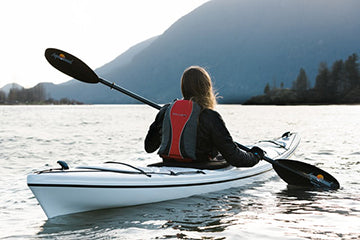
Kayaking Basics – A Beginner’s Guide
Share

If you’ve ever watched a group of kayakers paddling peacefully along a waterway, enjoying the sun and scenery, you have some idea of the attraction of this sport. Kayaking is simple enough for the faint of heart, yet can be taken to extreme in dangerous waters for the more adventurous. Beginning your kayaking adventure is easy if you keep a few tips in mind.
Starting Out
The first step in becoming an experienced kayaker is to try out the sport in a small way to get the feel of it. Many vacation areas offer kayak rentals to visitors on well-marked waterways. This trial run will give you a good idea of whether you have the stamina for kayaking and the flexibility for getting in an out of the craft. Remember that your arms and shoulders will become stronger as you gain experience. With a little practice, you will soon learn how to maneuver the kayak forward and backward, as well as the best ways to leave and approach the launch area.
Basic Paddling Techniques
The kayak paddle has blades on both ends that can go into the water alternately to provide a continuous motion. Sit in an upright position rather than leaning back to give the stroke more strength. Grasp the paddle with both hands in the middle. Your hands should be far enough apart to feel comfortable. Line up your knuckles with the upward blade edge. To move the kayak forward, place the blade in the water at about the area where your feet are in the kayak. Draw the paddle backward, holding it close to the side of the craft. Rotate the other end to the front where your feet are in the kayak and move the blade in the same manner on the other side. Repeat until you achieve a smooth and rhythmic, gliding motion. To turn the craft, paddle on the opposite side of the direction you wish to turn. To back up the kayak, reverse the motion, placing the paddle slightly behind you on the side of the boat and pulling it forward.
Choosing Your Kayak
When you’re ready to buy your own kayak, you should consider your choices before purchasing. Kayaks come in rigid, folding and inflatable types. With rigid types, you can choose between a sit-on-top kayak or one that you sit on the floor of the craft with the sides of the kayak protecting you. Both types have certain advantages. The sit-on-top kayak is generally lighter and easier to maneuver than the on-floor type. The on-floor type offers a drier ride in cold waters.
Kayaking Equipment
In addition to the craft, you will need a sturdy, well-balance paddle, a PFD, some line for tying up the kayak when necessary and a small repair kit for your type of craft. A small first-aid kit is a good idea for those sudden accidents while on the kayak trail. A small flashlight is handy if you find yourself paddling after dark. You should also carry a small signal device, such as a whistle in case of difficulty.
Kayaking Venues
Kayakers can find waterways that can differ greatly when they travel. Some areas only offer smooth water. Other areas of the country have numerous whitewater areas that require advanced skills. Ocean kayaking is available in some areas. Shoreline kayaking is a safe option for some areas of the country. Other regions of the country may offer small estuaries to explore. State and national parks may offer both marked water trails and wilderness areas. If you read about your kayaking destination in advance, you will have a good idea of the type of waterways that are available for you when you’re ready to hit the water.
Increasing Challenges Gradually
Safe kayaking requires that the paddler understand that every waterway can offer a different challenge. Some waterways can be confusing with many tributaries. It can be easy to get lost on a strange waterway. Trees on the shoreline can all look alike. There may be no buildings or trail markers to guide you. You should always locate a trail map in advance and keep the map with you at all times to avoid getting lost. This precaution can help you avoid getting fatigued trying to find your way or paddling in the darkness. When approaching a new paddling trail or body of water, do some research on what you can expect. Only tackle rapid water that you can handle. As you become more confident, you can begin increasing the challenges to suit your experience level.
Safety Precautions
Always wear your personal flotation device when paddling, particularly in strange waters where sudden obstacles or water conditions can create hazards. Wear a hat to keep the sun off your face and wear sunscreen. Bring plenty of water for the kayak trip, at least one bottle for each hour you are on the trail. Also, pack to give you energy along the way.
When you kayak in a group, set the pace with the slowest member. Be alert to paddlers’ fatigue or any difficulties with position or equipment. For long trips, bring a fully-charged cellphone with you in case of medical emergencies. Always tell someone where you will be paddling in case a problem arises.
